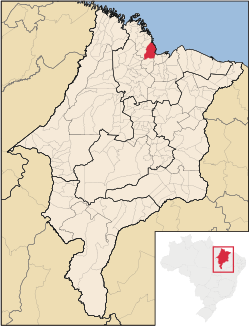 | |
Left to right from the top: VLS Pad, Control Center, Command Room, Tracking Antenna, Alcântara area from space | |
 Location of the Alcântara Space Center | |
| Abbreviation | CEA |
|---|---|
| Formation | 1982 |
| Type | Spaceport |
| Location | |
| Coordinates | 02°20′22″S44°25′03″W / 2.33944°S 44.41750°W |
Official language | Portuguese English |
| Owner | Aerospace Operations Command Brazilian Air Force Brazilian Space Agency |
Director | Col. Marcello Correa De Souza |
| Website | fab |
Formerly called | Alcântara Launch Center |
| [1] [2] | |
The Alcântara Space Center (Portuguese : Centro Espacial de Alcântara, CEA), former known as Alcântara Launch Center (Portuguese : Centro de Lançamento de Alcântara, [3] ) is a space center and launching facility of the Brazilian Space Agency in the city of Alcântara, located on Brazil's northern Atlantic coast, in the state of Maranhão. [4] It is operated by the Brazilian Air Force (Comando da Aeronáutica). The CEA is the closest launching base to the equator. This gives the launch site a significant advantage in launching geosynchronous satellites, an attribute shared by the Guiana Space Centre.
Contents
- Construction
- Controversies
- Public-private partnership
- Agreement between Brazil and the U.S.
- Structures
- List of launchpads
- Launch list
- Alcântara Space Center (from 2021)
- Alcântara Launch Center (1982-2022)
- See also
- References
- External links
Construction of the base began in 1982. The first launch occurred on February 21, 1990, when the sounding rocket Sonda 2 XV-53 was launched. [5] On August 22, 2003, the explosion of the third VLS-1 (XV-03) killed 21 people. [6]
The facility is in a strong position for launching satellites into geosynchronous orbits, according to British astrophysicist, Jonathan McDowell. [7] As such, there are plans to launch several international rockets from Alcântara. In 2003 contracts were signed to launch Ukrainian Tsyklon-4 [8] and Israeli Shavit [9] rockets, thought these may have later been launched from their home countries in Ukraine [10] and Israel. [11] In addition there are further plans to launch the Russian Proton rocket. [12]
In the beginning of 2018, Brazilian government offered the possibility to use the spaceport to several U.S. companies. [13] The company Virgin Orbit, was selected to fly their LauncherOne rocket from Alcântara in the first half of 2023. [14] [15]


